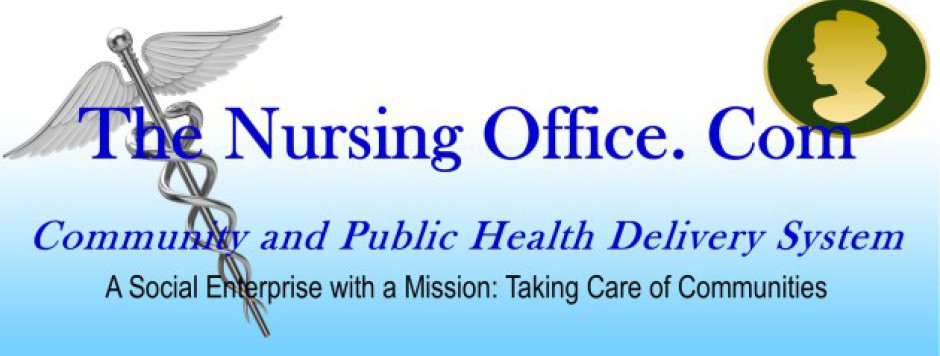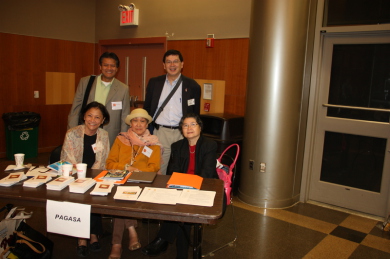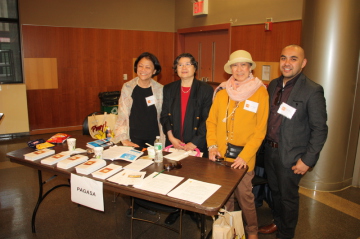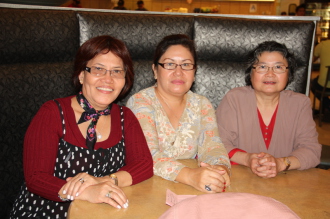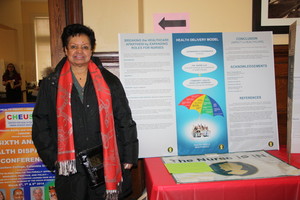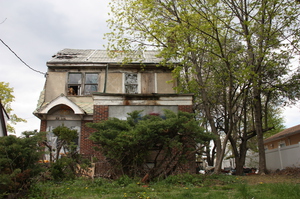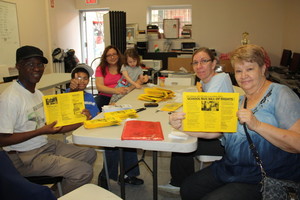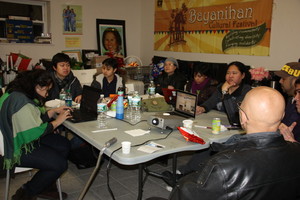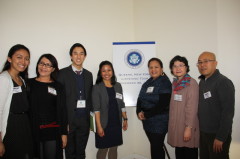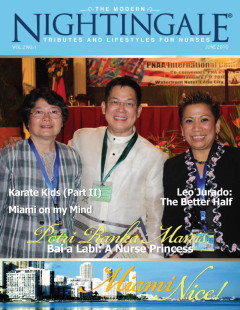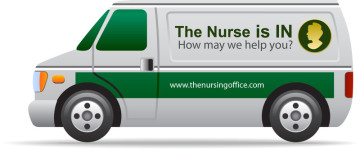Home Health Aide Training
Abstract/Executive Summary
During this unprecedented time of the COVID-19 pandemic, the need for solutions to the myriad problems affecting seniors are called for more than ever. From the frontline of the communities, we have worked harder to make a difference in offering evidenced based strategies from the joint perspective of scientists, economists, doctors, nurses and the government on how the individuals and the world respond to live and survive in this uncertain time. A timely offering of a grant by the AARP Foundation gave us an inspiration to move on with our Nurse-Driven Healthcare Solutions to develop a model based on a theory of change that will maximize the continuum of education, economic advancement and healthcare as a stimulus package to benefit seniors.
Background
With an increasingly aging population, the cost of healthcare has also increased. Ironically, the solution has been deemed going back to the basics by using strategies and resources almost always readily available, individuals and their families. The first line of defense for affordable care is with Home Caregivers. The provision of well-trained homecare givers contributes to affordable healthcare, in addition to Improving financial sustainability among low income seniors (LI 50+).
To address the enormous social and economic need for basic, competent, low-cost healthcare, we at The Nursing Office took this initiative of developing a curriculum for Online Training Home Caregivers as our foremost Nurse-Driven Healthcare Solutions.
Problem
Based on the background, three general needs are identified on the issues relevant to the mission and vision of AARP Foundation: 1) Education 2) Economic Advancement of LI 50+ 3) Healthcare Benefits
Healthcare Economics
Whether paid or unpaid, skilled, or unskilled, Home Caregiving has tremendous value. The amount of caregiving done as unpaid work exceeds the amount done as work for hire. In the United States, for example, a 1997 study estimated the labor value of unpaid caregiving at US$196 billion, while the formal home healthcare work sector generated US$32 billion and nursing home care generated US$83 billion in costs. Because of the enormous personal investment made in this sector, Home Caregiving deserves the support of social programs easy to access and use, thereby increasing the cost effectiveness of training Low-Income 50+ Home Caregivers.
Our Organization
The Nursing Office.Com is a
14-year-old nonprofit organization taking care of nurses and communities through its Community and Public Health Delivery System called, “The Nurse is IN” program. “.COM” stands also for
Communities, and as such, it is the Nursing Office for Communities.
The Nursing Office.Com provides organizational and technical support to community organizations and develops coalitions and partnerships for its Healthcare Delivery Model, under the philosophy of
“Shared Mission, Shared Governance and Shared Resources.” The Nursing Office.Com maintains offices in Queens and Manhattan and operates a Community Center as well, particularly The Philippine
Community Center Services for Aging (PCCSA, Inc.) a 501(c)(3) organization.
https://www.thenursingoffice.com/philippine-community-center-services-for-aging/, and the Irene Lumbrera Home Living Program, a Nurse-Driven Housing Solution. https://www.thenursingoffice.com/services-programs/nurse-driven-housing-solutions/home-living-program/
https://www.thenursingoffice.com/the-nursing-office-org/
Nurse-driven Healthcare Solution:
Online Home Health Aide Training
While a hands-on training in a classroom is ideal, the Online HHA Training of The Nursing Office Annex https://www.thenursingoffice.com/the-nursing-annex/ is a timely strategy ensuring that all the goals of training are met, and Home Health Aides are skills-trained to their full competency while social distancing and other limitations relating to the pandemic exist.
The Art of Care Giving: A Vocational Training Curriculum There is no substitute to a full-length reference book on Providing Home Care. For the sake of easier, effective, adult learning as a Home Care Giver, we will simplify the Methodology and the Curriculum, as a science and art, based on strong principles as a foundation of a lifelong skill and competency for the performance and delivery of the best care ever.
Training Goal: To train each Home Caregiver Basic Skills and the Art of Home Caregiving.
Training Objectives:
1. To provide culturally competent and sensitive training in Home Caregiving skills to family members already taking care of loved ones, from immigrants interested in developing caregiving skills to other community members in Queens, Bronx, Brooklyn, Manhattan, and Staten Island.
2. To provide an affordable training program in Home Caregiving to able-bodied senior LI (50+) immigrants and other unemployed or under-employed community members in the five boroughs.
3. To upgrade the skills of the unemployed or underemployed able-bodied LI 50+ Seniors and other community members.
4. To open employment opportunities and provide placement service for LI Seniors 50+ who have undergone previous Home Caregiving skills training.
I Introduction to Home Care Giving (Companion Care Education)
- Course Description
- General Information
- Registration
- Technical Support
- Self-Assessment
- Understanding Healthcare
- Preparing to Become a Home Care Giver
- Principles in Home Care Giving
- Golden Rule/ Do No Harm/ Negligence
- Guidelines & Standards in Home Care Giving
- Unique Personalized Service
- Understanding Culture and Diversity/Culturally Appropriate Care
II The 4 H of Home Care Giving: Head, Heart, Hands, Health
- Legal, Ethical, Moral Responsibilities
- Job Description of a Home Health Aide
- Decision Making Process
- How to make Care Plans for Home Health Aides
- Developing a Lasting Relationship with Patients & Family
III Happyness: Aim for Health
- The Culture of Health
- Emotional Intelligence
- Family and Community Approach to Mental Health
IV The Common Diseases
Common Health and Medical Terminologies
Common Medical Conditions and Diseases
- Hypertension
- Diabetes
- Dementia
- Alzheimers
- Other Chronic Conditions & Diseases
V Safety Training: Patient Handling
- Body Mechanics and Techniques in Mobility Assistance
- Elder Abuse & Neglect
- Skin Care: The First Line of Defense
- Documentation & Reporting
VI Infection Control
- COVID 19 (Corona Virus Infection)
- Tuberculosis
- Hepatitis
- AIDS
- Universal Precautions
- Personal Protective Equipment
- Hygiene
- Nutrition
VII Activities of Daily Living
- Bathing
- Feeding
- Walking
- Getting in and out of bed
- Medication Administration
- Vital Signs/ BP Taking
- Glucose testing
- Other Occupational/Recreational Activities
VIII Common Emergencies
- Basic Emergency Principles
- Heart Attack
- Stroke
- Falls
- How to Alert Emergency Calls, 911
IX Care Giver Fatigue/ Care Giver Support
- Stress Reduction Strategies
- Basic Computer Skills
- Basic Financial Literacy
- “I love Caregivers” … AARP
X Beyond Home Care Giving
- Spirituality
- Kindness
XI Course Completion
- SKILLS & COMPETENCY CLEARANCE
- TESTING & EVALUATION
- CERTIFICATE of ATTENDANCE
SWOT Analysis
The Nursing Office Difference
“Making a Difference in Home Care Giving”
Designed by nurses with extensive years of experience in nursing and related care giving and healthcare system in general, this Training Program for Home Caregivers, is based on evidence and careful application of sound principles and healthcare economics, reflect the elements of Interdisciplinary, holistic, natural, cultural, family oriented, patient centered healthcare delivery in a patient centered medical home environment. By integrating behavioral health (mental health) in public and community healthcare systems bring about better home care givers, better patient outcomes and reduced healthcare cost. We will move healthcare closer to a population care model, starting from the smallest unit, individuals, and families and into the larger communities.
Aligning Mission, Goals and Objectives with AARP
The Nursing Office.Com has a non-profit 501 c3 charitable organization for its Services to Aging Immigrants, namely, The Philippine Community Center Services for Aging, Inc. This has given us a n opportunity to learn more of AARP’s services and programs on “I love Caregivers” through Mr. Steven Raga and Retired US Major Antonio Taguba. This has aligned our missions and visions, goals, and objectives for the elderly with that of AARP. We are happy to promote the status of the seniors.
Advantages to Low-Income 50+ Workers: While they may have less technical skills compared with millennials and are disadvantaged by reduced work or employment during the lockdown, 50+ workers possess strong work ethic, longer life experience, caring attitudes and are reliable, eager and willing to learn, qualities that Home Caregivers must have. With proper education, job coaching & job placement assistance (which includes Case finding of seniors qualified for home care), the 50+ workers’ personal qualities are useful assets in the complex job of home caregiving.
While they have less technical skills and cannot compete with millennials as well as the unemployment during
this lockdown, they have strong work ethics, they can easily become home care givers because of their experience and reliability, as well as their eagerness and willingness to learn and add to
their already caring attitudes and skills.
Back to work 50 + connects older LI adults with nonprofits that provide training, job search coaching and assistance and access to employers.
Description/Process of the Intervention (Step by Step)
This timely opportunity for a grant has inspired us to move on with our plan to be able to make a difference among our LI 50+ seniors in a time of crisis like this pandemic. Incidentally, we have seen a clear continuum of education, economic advancement and healthcare that may guide us for future programs and services to further deliver a stimulus to our seniors and the nation in general.
- Conceptualizing Project and Program Design (Project Development and Description)
- Program Planning Timeline
- Curriculum Development
- Strategic Planning from Organizational Level
- Strategic Planning for Training and Program Delivery
- Technical Set Up (Tablets and Internet Connections)
- Setting up the Online Classroom
- Videotaping of Instructional Materials online
- Establishing networks and organizational alliances (Promotion Drive)
- Screening of Applicants
- Registration
- Start Online Classes for HHA
- Delivery of a Successful Program
- Assessment and Evaluation of the Program
Our Virtual Online Classrooms are set in the privacy of Trainees’ homes, available 24/7, with carefully chosen and designed tools for each person to learn how to become an effective Home Health Caregiver.
Google Classroom: In the Comfort of Your Homehttps://accounts.google.com/ServiceLogin/signinchooser?service=classroom&passive=1209600&continue=https%3A%2F%2Fclassroom.google.com%2F&followup=https%3A%2F%2Fclassroom.google.com%2F&emr=1&flowName=GlifWebSignIn&flowEntry=ServiceLogin
Methodology: (Participative Adult
Learning Pedagogy)
Lecture, Audio-Visuals, Hand-Outs, Role Playing, Home Health Aide Handbook, Return Demonstration, Sharing
Experiences, Practical Tests, Q & A
Total Training/Learning Hours: 75 hours (Individualized and personalized for every HHA Student based on
their Assessed Learning Needs)
Class Size: Virtual/Online Classroom up to 20 registrants/students per schedule
Course Duration: 60 days equivalent to 75 hours of instruction
Cost: $600.00 per student registrant
Academic Requirement: High School diploma or GED
Registration: Data Form
Minimum Requirements:
- Must speak read and understand English
- Must show NYC ID or any picture ID for proper identification
- Fill out The Nursing Office Registration Forms
The Nursing Office service includes:
- Certificate of Attendance
- Job referral and placement as available
- Recommendation Letter for higher advanced training in Home Healthcare Programs
- Career Ladder Counseling
Case Studies (for Data Input/Output, Assessment/Evaluation of Outcomes)
MS is a retired nurse who manages a Home Living Program facility and have 2 homeless seniors. She is
officially the caregiver of a 91- year old under the CDPAP program. Her income was donated 90% to cover the housing cost of the 2 homeless seniors.
CS, a new immigrant nurse had an unexpected stroke and had totally recovered. Her rehabilitation was facilitated when she assumed her home healthcare job. This helped her regain her independence and
self-esteem.
TA is a 72-year old who has been working with elderlies under CDPAP. She has contributed financially to the family finances and still able to send money to her children in their native
country.
Legal & Professional Guidelines Adapted from the NYS Department of Health and the Department of Education for Home Health Aide Training Program (HHATP)
HHATP Approval
The New York State Department of Health and/or the New York State Education Department approve Home Health Aide Training Programs. Agencies must choose to operate home health aide training programs under the approval of either the New York State Department of Health or the New York State Education Department. Home health aide training programs cannot be dually approved by both the New York State Department of Health and the New York State Education Department.
Registry
The New York State Department of Health maintain a registry of persons who have successfully completed a home health aide training and/or personal care training program. The home health aide training program issues the home health aide certificates upon successful completion of the program. The Home Care Registry generates certificates for aides trained after September 25, 2009. Each certificate has a Home Care Registry number and a certificate number printed on it and is signed by the appropriate staff of the training program.
Certificates
Home health aide training programs are required to maintain records for six years of those aides who received certificates upon successful completion of their program. The New York State Department of Health can only verify that a home health aide training program existed at the time that the certificate was issued. For aides trained after September 25, 2009, the aide's certificate is generated by the Registry and based on information entered into the system by the training program. The hiring agency must contact the previous employer, obtain a work reference and verify that the applicant worked in compliance with regulation as a home health aide (the previous employer may also have a copy of the original certificate on file that they verified at the start of employment). If records are not available and/or the previous employer is not accessible to provide documentation, the agency must advise the individual to repeat the training. For aides trained after September 25, 2009, the aide's certificate is generated by the Registry and based on information entered into the system by the training program.
Home health aides in New York State remain certified as long as they work for a home health agency, which is certified or licensed by the New York State Department of Health. The home health agency where the home health aide is employed must provide nursing supervision and 12 hours of in-service training per year. If the aide leaves the employment of an agency to work privately in New York State or to work out-of-state, the home health aide certification lapses two years from the date that the person last worked at a home health agency in New York State.
The written sworn statement or certification must be executed (printed, signed and notarized) within ten (10) business days of the trainee's successful completion of the training program. Certificates must be issued to aides within ten (10) business days of the day the certification was executed.
The HCR application does not allow the issuance of PCA certificates to aides enrolled in HHA classes. If a student is enrolled in an HHATP, that student must successfully complete the HHATP to receive his/her certificate. An aide who successfully completes a PCATP can be enrolled in a PCA Upgrade training, for which he/she may receive an HHA certificate upon successful completion.
Training Schedule
All approved home health aide training programs are expected to submit an anticipated schedule of training every six months to the appropriate regional office. Please refer to page 13 in the Guide and Attachment 5.
Course Training Duration
Home health aide training programs are allowed 60 days from the day an individual enters the program to complete the 75 hours. The 75 hours includes 59 hours classroom and 16 hours of supervised practical training as follows:
Home Care Curriculum – 40 hours (all classroom)
Health Related Task Curriculum – 35 hours (19 hours classroom plus 16 hours of supervised practical training). At a minimum, fifty percent (50%) of each trainee's supervised practical training must be provided in a patient care setting.
Extenuating circumstances which prevent a trainee from completing the required coursework within the 60-day time frame should be brought to the attention of the regional home care program manager on a case by case basis.
Tuition and Fees
A home health aide training program approved by the New York State Department of Health may not charge tuition but, a program approved by the New York State Education Department is allowed to charge tuition. A participant fee not to exceed $100.00 may be charged for materials that students are required to have; they will retain these materials upon completion or separation from the program.
Training Sites (Items 15, 16, 17 & 18 may not be applicable to an online HHA Training Program. Instead, general DOE guidelines for online teaching and/or learning will be applied.)
Program Training Requirements
The training program must conduct one full 75-hour training program class every three (3) years; and approve and issue at least one original certificate per year in order to remain an active approved program. This would include a certificate issued for Competency Evaluation Program, Personal Care Aide Upgrading or CNA Transitioning.
The program requirements are program-driven, not site-driven. One full 75-hour training program class must be conducted within a three-year period to maintain an on-going training program approval. Competency evaluations, PCA upgrades and nurse aide transitioning are not full training (75 hour) program classes. Failure to conduct the full training program will require reapplication for approval.
Do existing training programs have to resubmit a new application for re-approval including new requirements? If yes, what is the deadline for submission?
Effective July 1, 2012 all existing HHATPs must comply with the requirements described in the revised Guide.
Competency Evaluation
Individuals eligible to complete the competency evaluation program only, in lieu of the standardized training, include:
· A nursing assistant with one year of full-time experience in a general hospital within the past five (5) years;
· An individual with documented home health aide or nurse aide training and competency evaluation from an out-of-state training program;
· A home health aide with documented home health aide training and competency evaluation who has not been employed as a home health aide for 24 consecutive months;
· A nursing student who has documented evidence of successful completion of course work requiring mastery of home health aide tasks within the past 24 months. Documentation would include a transcript with passing grade(s) and course description(s) or skills checklist signed by the nursing school instructor.
· Veterans who were trained in the United States Military as medical technicians or medics.
An agency that operates a home health aide training program can provide a competency evaluation which includes a written exam and a demonstration of skills.
Home health aide training programs must have the capability to augment a nurse aide's training with classroom and supervised practical training in those skills not included in the nurse aide training program. Such skills include but are not limited to: assistance with medications; handling the patient's money; maintaining a clean, safe home environment; safety, accident prevention and responses to emergencies in the home; taking of blood pressure; and observing, recording and reporting in the home care setting. A nurse aide who is registered in the New York State Nurse Aide Registry is not required to repeat training in the content and skills learned in the nurse aide training program. However, the home health aide training program must assure that the nurse aide is competent in such skills prior to providing additional training and issuing a home health aide certificate. The Home Health Aide must be provided with a copy of the HHA Trainee Evaluation Form (Appendix 5 and 5A).
A CNA who is registered in the NYS Nurse Aide Registry is not required to repeat training in the content and skills learned in a previous training program. However, the HHATP must ensure that the CNA is competent in such skills prior to providing additional training and issuing a home health aide certificate.
Training and Testing Materials
The Department will not publish a list of acceptable published textbooks. Each new class should be given a new test. If a trainee has to retake the exam after an unsuccessful attempt this new test must be a different version than the previous test taken. The program should develop policies and procedures as to how it will ensure that the test taking sessions are secure. There should be a sufficient number of questions to ensure that the individual knows the material. The test bank chosen will dictate the number of questions needed to cover the material in each unit.
(Note: Items 30, 31, 32 & 33 refer to training site facilities, like kitchen, running water & equipment, which may not be applicable in an online training.)
Textbooks and associated written tests must be available in the language that is being taught. The Department maintains the authority to review and approve a textbook to be used for this purpose to ensure that the curriculum meets the minimum standards.
A copy of the test to correspond with the answer key must also be retained. A master copy of the questions which relates to the answer key must be retained.
Since the new guidelines go into effect for existing programs at the time of their re-approval submission, are the textbooks and tests currently in use acceptable until then as well?
Yes, the textbooks and tests currently in use are acceptable until July 1, 2012 when revisions will become effective for all Home Health Aide Training Programs.
Are we now required to use the HHATP form in Appendix 5 as documentation?
Yes.
Do we still need to use the tests and check-off sheets from the old curriculum?
No.
Must we submit a list of the videos we are using or only indicate we are using videos while an approved instructor will be in the room?
You must indicate (by name) which videos you are using as a supplement to the curriculum.
If a HHATP is approved through July 2014, do we have to make all the required changes by July 2012?
Yes. All administrative changes must be made by July 1, 2012 to remain in compliance. However, if a HHATP is planning to make changes to the curriculum, instructors, sites, etc. then you need to submit those changes to DOH.
Nurse Instructor
There can be more than one Nurse Instructor for a class, as long as each is an Approved Nurse Instructor. A LPN can be an adjunct faculty and provide some of the instruction under the direct supervision of an approved Nurse Instructor. The approved Nurse Instructor must be physically present during the entire time of the instruction provided by an LPN. An adjunct faculty such as a Licensed Physical Therapist or Registered Dietitian does not have to have an approved Nurse Instructor present during instruction.
The Regional DOH office must be notified of any changes in the nurse instructor. The attached nurse instructor application with specific documentation on foreign language must be submitted. If acceptable, the local regional DOH office will have the HCR updated. It is not required to notify the Regional Office of a substitute; however, the substitute must be an approved Nurse Instructor for the program and listed on the HCR.
Quality Assurance/Quality Improvement
The guidelines state that all programs are required to conduct monitoring on at least a quarterly basis.
Program monitoring is expected to be program-specific, not site-specific and performed quarterly. Quarterly meeting minutes will not satisfy the requirement to submit an annual evaluation report. The annual evaluation report must include analysis and evaluation of program's educational outcomes that address the effectiveness of the:
· Instructor(s)
· Lesson plans
· Equipment and other materials utilized to achieve learning objectives, e.g. videos, textbooks, etc.
· Evaluation of the supervised practical training site(s)
· Student evaluation of the program, including effectiveness of communication between instructor and students of testing results, admission standards and program completion rates
Trainee Rights
The program may use the DOH Trainee Rights form verbatim. All trainees, regardless of the training program in which the trainee is enrolled, must receive a copy of the Trainee Rights. The Trainee Rights must be given to every trainee at, or prior to, the first class. The training program must maintain documentation of receipt of these rights.
References & Resources
https://www.health.ny.gov/professionals/home_care/hhtap_training_program_faq.htm
Guide to Operation of a Home Health Aide Training Program based from DOE Guidelines
INTRODUCTION
The purpose of this Guide is to clarify for certified home health agencies (CHHAs), long term home health care programs (LTHHCPs), licensed home care services agencies (LHCSAs), and hospices, hereafter referred to as home care agencies, the New York State Home Health Aide Training Program (HHATP) requirements, and the process and procedures for Department of Health (NYSDOH) initial approval and re-approval of HHATPs. These requirements supersede the requirements set forth in the New York State Department of Health's Guide to Home Health Aide Training and Competency Evaluation (1992) and (2006) and Guide to Operation of a Home Health Aide Training Program (February 1, 2012). The training and evaluation requirements and approval process set forth in this guide are consistent with Part 484 of Title 42 of the Code of Federal Regulations (42 CFR) and Section 700.2 of Title 10 of the New York Code, Rules and Regulations (10 NYCRR).
In order to provide home health aide services in New York State, a person must successfully complete training and competency evaluation program or competency evaluation program only conducted by an approved HHATP and be issued a certificate of completion. Any questions regarding home health aide training and program approval requirements should be directed to the appropriate NYSDOH regional office Home Care Program Manager. (Attachment 1)
TRAINING REQUIREMENTS
A HHATP must include classroom and supervised practical training. The aide trainee must receive a minimum of 75 hours of training including a minimum of 59 hours classroom and 16 hours of supervised practical training. Required testing and competency evaluation are not included in the 75 hours. Supervised practical training means training in a skills laboratory, patient's home or other health care setting in which the trainee demonstrates knowledge while performing tasks on an individual under the direct supervision of an approved Nurse Instructor. (Please refer to requirements for Nurse Instructor) At a minimum, fifty percent (50%) or 8 hours of each aide's supervised practical training must be provided in a patient care setting. The setting(s) used for practical training and the number of training hours provided must be based on each trainee’s learning needs. Supervised practical training may take place in any setting where patient care can occur except in nursing homes (skilled nursing facilities). Services provided by a trainee during supervised practical training are not reimbursable by Medicaid. It is permissible for the entire 16 hours of SPT to occur in the skills laboratory ONLY for trainees who have been employed as certified Personal Care Aides (PCAs) and have experience providing personal care services in patients’ home, and enrolled in the Personal Care Aide Upgrading program. The trainee must have been employed as a certified Personal Care Aide and have direct experience providing services to home health patients in 5 their homes. Additionally, none of the experience providing care to patients as a PCA can be used to satisfy the SPT requirement for the home health aide training program. Federal regulations found in 42 CFR Part 484.36 specify that a mannequin cannot be used for SPT purposes. A volunteer or “pseudo-patient” must be used during the SPT in a laboratory setting. The HHATP must have a record that distinguishes between the skills taught at a patient’s bedside, with supervision, and those taught in a laboratory using a volunteer or “pseudo-patient The maximum number of trainees to the approved Nurse Instructor ratio is 20:1 in the classroom setting and 10:1 for supervised practical training in the skills laboratory and patient care setting. The number of trainees must be consistent with the available space in the classroom and appropriate to the supervised practical training location. (See space requirements found on page 11)
STANDARDIZED CURRICULAR CONTENT
Each HHATP must identify and clearly state its goals and objectives and must include measurable performance criteria specific to both the curricular subject material and clinical content required by the Department. We recommend that the curriculum be taught at a sixth grade reading level. In order to assure that all HHATPs are teaching comparable content, HHATPs are required to base their training, including lesson plans, on the content of the Home Care Curriculum (HCC) and Health Related Tasks Curriculum (HRTC) available on the DOH website and Health Commerce System (HCS). The training program's teaching staff may exercise discretion in determining the amount of time required to adequately teach each of the subject areas, however, the minimum training time required must be met for each subject area and the training hours must total a minimum of 75 hours. Other resources may be used at the discretion of the approved Nurse Instructor supervising the approved HHATP.
EVALUATION OF THE TRAINEE
The HHATP is also responsible for ensuring that each home health aide trainee is competent in each skill and procedure taught in the training program. Competency evaluation may be integrated throughout the training program or may be conducted subsequent to classroom and supervised practical training. Competency must be evaluated by an approved Nurse Instructor. The following methods must be utilized in the evaluation of competency: · written and/or oral examinations that demonstrate the trainee’s knowledge of the information presented in the classroom training; and · observation and demonstration by the trainee of his/her competency in performing the required skills in the laboratory or patient care setting. 6 All training programs are required to use a published text consistent with the content of the Department’s HCC and HRTC curriculum. To evaluate each home health aide trainee's competence in performing the minimally required number of home health skills, each HHATP must utilize the procedure checklists found in the appendices of HCC and HRTC curriculum and written tests obtained from publishers who publish text books for the purpose of training home health aides. Test questions must be obtained from a “bank” of test questions. Questions must comprehensively test the student in all areas of the curriculum and questions must be rotated. If a student is retaking a test after an unsuccessful attempt, this test must be a different version from the previous test taken. A minimum score of 80% is required to ensure mastery of subject material. Documentation of Competency: For each home health aide who has completed classroom and supervised practical training, all competencies must be documented on a Trainee Evaluation Form(s) (Appendix 5, 5a). The trainee evaluation form must include documentation of the competencies which were demonstrated proficiently, name, license number and initials of the approved Nurse Instructor who has evaluated the trainee’s performance of each task and the date completed. Classroom and supervised practical training and competency evaluation must be completed within 60 calendar days of each trainee’s entry into the training program.
COMPETENCY EVALUATION PROGRAM
In lieu of the standardized training and competency evaluation, the HHATP must make available to eligible individuals a competency evaluation program. The competency evaluation program must be derived from a comprehensive written test and procedure demonstration checklists derived from the program’s full training program. The written and procedure demonstration portions of the competency evaluation program must contain sufficient content to assure that the aide is competent in the information and required skills set forth in the HCC and HRTC curricula. Individuals eligible to complete the competency evaluation program only, in lieu of the standardized training, include: · A nursing assistant with one year of full time experience in a general hospital within the past five years; · An individual with documented home health aide or nurse aide training and competency evaluation from an out-of-state training program; · A home health aide with documented home health aide training and competency evaluation who has not been employed as a home health aide for 24 consecutive months; · A nursing student who has documented evidence of successful completion of course work requiring mastery of home health aide tasks within the past 24 months. 7 Documentation would include a transcript with passing grade(s) and course description(s) or skills checklist signed by the nursing school instructor; and · Veterans who were trained in the United States Military as medical technicians or medics. If a prospective home health aide demonstrates competency in some, but not all of the content and skills evaluated, the HHATP must provide additional training, as appropriate, and reevaluate the aide's competency only in those areas requiring remediation. The trainee will be issued a Certificate of Completion upon successful completion of the competency evaluation program. This certificate will identify the training methodology as competency evaluation.
NOTE:
A registered professional nurse or a licensed practical nurse currently licensed and registered in the State of New York may be employed as a home health aide and will be considered exempt from training and competency evaluation requirements. The possession of a current valid registration as a nurse from the New York State Department of Education (NYSED), Office of the Professions precludes the need for a home health aide certificate.
PERSONAL CARE AIDE UPGRADING
Personal care aides (Level II) are permitted to perform fewer health-related tasks than home health aides. Personal care aides, who have been trained in approved personal care activities, are issued a certificate from a NYSDOH or NYSED approved training program, which must offer a minimum of 40 hours of training. To upgrade a personal care aide to a home health aide, HHATPs must provide the 35 hours of training outlined in the HRTC. This includes 19 hours of classroom and 16 hours of supervised practical training as previously described under Training Requirements. The Personal Care Aide Upgrading is intended for individuals who have been employed as personal care aides and have direct experience providing personal care services to home health patients in their homes. A trainee may not move directly from a Personal Care Aide training program to a Personal Care Aide Upgrading program for purposes of completing the requirements to become a home health aide. The HRTC appendix indicates the 18 required performance standards, which must be successfully demonstrated to and assessed by an approved Nurse Instructor. A personal care aide with a valid personal care aide certificate is not required to repeat training in the content and skills learned in the basic personal care aide training program. However, the HHATP must assure that the personal care aide is competent in such skills prior to providing additional training and issuing a home health aide certificate. Documentation of the successful completion of the 35 hours of training and proof of competency in the content and skills required by the personal care aide training program must be kept in the individual’s file.
8 CERTIFIED NURSE AIDE TRANSITIONING Certified nurse aides (CNAs) employed in residential health care facilities (RHCF, commonly known as nursing homes) provide personal care and health-related services, which are comparable to the activities and tasks performed by home health aides. A CNA who is employed in a RHCF is required to be certified in accordance with the provisions of Section 415.26 of Title 10 of NYCRR. In order to obtain nurse aide certification and be listed in the New York State RHCF Nurse Aide Registry, an individual must successfully complete a State-approved RHCF nurse aide training program, which is a minimum of 100 hours in duration, and pass the State-authorized competency examination. HHATPs must have the capability to augment a nurse aide's training with classroom and supervised practical training in those skills not included in the nurse aide training program. Such skills include but are not limited to: assistance with medications; handling the patient's money; maintaining a clean, safe home environment; safety, accident prevention and responses to emergencies in the home; taking of blood pressure; and observing, recording and reporting in the home care setting. A CNA who is registered in the New York State Nurse Aide Registry is not required to repeat training in the content and skills learned in a previous training program. However, the HHATP must assure that the CNA is competent in such skills prior to providing additional training and issuing a home health aide certificate.
DOCUMENTATION OF SUCCESSFUL COMPLETION OF THE TRAINING PROGRAM
Home health aide training program certificates are issued by the training program through the Home Care Registry (HCR). HHATPs must follow the directives and advisories promulgated by the HCR in regards to documentation of completion of training and the issuance of certificates. The original certificate must be issued to the individual who has successfully completed the program within the timeframes required by the HCR. The home health aide must also be provided with a copy of the completed Home Health Aide Trainee Evaluation Forms (Appendix 5 and 5a). The training program must maintain copies of each aide’s training certificate and trainee evaluation forms for at least six years. An individual who successfully completed an approved HHATP will not be considered qualified to provide home health aide services if that individual has not been employed as a home health aide in an Article 36 or 40 approved agency within any consecutive 24 month period. The home health aide who wishes to be re-employed after a two-year lapse in employment as a home health aide will be eligible to take the competency evaluation program in lieu of the standardized training program. After successful completion of the competency evaluation program, a new certificate will be issued to the home health aide by the training program conducting the competency evaluation program.
HOME HEALTH AIDE TRAINING PROGRAM APPROVAL REQUIREMENTS
Home Health Aide Training Programs can be approved by either NYSDOH or NYSED. Training programs cannot be dually approved by the NYSDOH and NYSED. A HHATP sponsored by an 9 educational facility which is regulated by the NYSED must meet the training and competency evaluation requirements established by the NYSED. Such requirements are consistent with the standards set forth in this Guide; however, program length may differ.
An educational facility wishing to conduct home health aide training may access information at http://www.highered.nysed.gov/bpss/steps.htm and must submit its proposed home health aide training program plan for approval to NYSED as follows:
For programs originating in for-profit schools that do not award academic credit:
Bureau of Proprietary School Supervision
Room 1613 OCP
One Commerce Plaza, 16th Floor 99 Washington Avenue Albany, NY 12234
Phone: 518-474-3969
http://www.access.nysed.gov/bpss/schools/steps.htm
For programs in BOCES and high schools:
Career and Technical Education
Education Building, Room 315 89
Washington Avenue Albany, NY 12234
Phone: 518-486-1547
For programs in colleges, universities and Educational Opportunity Centers:
Office of the Professions
Professional Education Program Review
Education Building, 2nd Floor West Wing
89 Washington Avenue Albany, NY 12234
Phone: 518-486-2967
Only a home care agency or hospice licensed under Article 36 or 40 of the Public Health Law may be approved to establish a home health aide training program through the NYSDOH and must meet the training and competency evaluation requirements as stipulated in this Guide. Applicants must submit its proposed program plan to the appropriate NYSDOH Home Care Program Manager (Attachment 1) for approval.
HHATPs approved by the NYSDOH are allowed to charge a trainee fee, up to a maximum of $100.00 (one hundred dollars) to recoup the cost of those items trainees are required to have (e.g. books, supplies, equipment) and which the individual trainee retains upon completion or separation from the program. The program must be able to verify an associated cost if a trainee fee is charged. Any program intending to charge over $100.00 in fees or tuition must apply to the NYSED for approval to operate and should not seek NYSDOH approval.
10 HOME HEALTH AIDE TRAINING PROGRAM REQUIREMENTS:
Faculty and Credentials: These requirements are derived from federal regulations found at 42 CFR 484.36(a)(2)(ii). Nurse Instructor: The HHATP must be provided by or under the direction of a registered professional nurse who:
· has two years of nursing experience; and
· at least one year of which must be in the provision of home health care services in an Article 36 or Article 40 approved agency or its out of state equivalent; and
· cannot be on the Office of Medicaid Inspector General’s (OMIG) list of Restricted, Terminated or Excluded Individuals or Entities or the U.S. Department of Health and Human Services Office of Inspector General’s list of Excluded Individuals/Entities. All Nurse Instructors must be approved by the Department prior to inclusion in the HCR instructor database.
The Nurse Instructor Application form(s) (Appendix
1) must be submitted to the NYSDOH regional office responsible for review and approval at least 30 days prior to the instructor teaching any classes. Nurse Instructor application(s) will be approved and entered into the HCR within 15 days of receipt of application. The regional office home care program manager will communicate in writing any Nurse Instructor application(s) that are disapproved. The training program must notify the regional office of any change in the status of approved Nurse Instructors such as resignations or extended leave within 10 business days of change. Failure to notify the regional office of a change in status of an approved Nurse Instructor or the addition of new Nurse Instructors may result in immediate disapproval of the program.
2) It is not necessary to notify the regional office of substitutions for the instructor as long as the substitute is an approved Nurse Instructor for that program in the registry.
3) Approved Nurse Instructor(s) responsibilities include: 1. Coordinating the didactic portion of the program 2. Conducting the supervised practical training 3. Performing all competency evaluations Coordinating Nurse Instructor: If there are multiple approved Nurse Instructors, the program must designate at least one approved Nurse Instructor to be responsible for the coordination of training activities and oversight to ensure that training and supervision of practical training is consistent. This designated Nurse Instructor would be listed on the program application as the Coordinating Nurse Instructor.
4) Adjunct Faculty: The use of other individuals such as a therapist or a dietician is encouraged as long as such individuals provide instruction under the supervision of the approved Coordinating Nurse Instructor.
11 A LPN can be an adjunct faculty and provide some of the instruction under the direct supervision of an approved Nurse Instructor. The approved Nurse Instructor must be physically present during the entire time of the instruction provided by an LPN. Confidentiality of Tests and Examinations: The program is required to have procedures for maintaining the confidentiality of all HHATP tests and examinations. All testing materials must be kept strictly confidential. Screening Training Applicants: Training programs are expected to develop procedures for screening for the appropriateness of training applicants.
Applicants should be selected on the basis of such factors as sympathetic attitude toward the care of the sick; ability to read, write, and carry out directions; maturity and ability to deal effectively with the demands of the job. A minimum age of 18 is recommended but not required. A list of resources regarding ability to read is available at: http://www.acces.nysed.gov/bpss/schools/pg60201.htm
Location, Equipment, and Space to be utilized for the Training:
At a minimum, the training site should include a classroom area for didactic presentation of curricular content and a laboratory area with equipment and supplies that enable trainers and trainees to adequately demonstrate clinical tasks. The training site must have the following: tables/desks and chairs, running water, kitchen facilities or a mock kitchen, audiovisual equipment storage space, electrical outlets and lighting. The space should be adequate to suit both the number of trainees and the equipment.
(Attachment 2 – Suggested Equipment List) Each trainee should have approximately 12-20 square feet of space in the classroom setting and 30 square feet of space in the clinical laboratory setting. Training space can be flexible in nature, meaning used for formal classroom instruction and rearranged for clinical laboratory instruction. A lease, Certificate of Occupancy or written agreement must be obtained prior to any training classes conducted on the premises.
Program Monitoring:
All programs are required to have policies and procedures describing their quality management program and the annual evaluation of the training program.
Quality management processes should focus on the overall operation of the training program and should address at a minimum the following:
· Monitoring for compliance with the requirements in this Guide
· Monitoring of contracts
· Analysis and evaluation of program’s educational outcomes that address the effectiveness of the: - Instructor(s) - Lesson plans - Equipment and other materials utilized to achieve learning objectives, e.g. videos, textbooks, etc. - Evaluation of the supervised practical training site(s)
12 - Student evaluation of the program, including effectiveness of communication between instructor and students - Analysis and evaluation of testing results, admission standards and program completion rates
· Development and implementation of strategies for improvement of the HHATP
· Submission of an annual evaluation report to the sponsoring agency’s governing authority and to the NYSDOH with the re-approval application.
All programs are required to conduct monitoring on at least a quarterly basis and documentation of such must be included in the quality assurance minutes of the sponsoring agency.
Programs may choose to utilize tools developed by the Department and provider workgroup which are found in Attachment 3a, 3b, and 3c.
Maintaining Training Records:
The HHATP must have a procedure to retain, for a period of at least six years, a training record for each person who has successfully completed home health aide training and/or competency evaluation, including:
· Documentation of the trainee’s receipt of the program’s Trainee Rights (Attachment 4). The Trainee Rights must be given to the student at or prior to the first class in a format (i.e. language, reading level) that the trainee can comprehend. These rights must address at a minimum, the items in Attachment 4 and any other rights the program chooses.
· Attendance sign-in sheet for classroom and supervised practical training; trainees must document their arrival and departure as well as the start and completion of their lunch break by signing their full name at the commencement of each day. They may use their initials for signing in/out for lunch and at the end of the day.
· Each trainee’s completed written tests and trainee evaluation forms.
· Copy of the training certificate of completion. Electronic record keeping is acceptable. Providers must ensure that electronic records are able to be produced upon request by DOH or any other regulatory agency. Providers must also ensure that appropriate electronic backup of these records exists.
Home Care Registry Requirements:
The training program must have policies and procedures demonstrating compliance with all requirements for the Home Care Registry (HCR) found on the Health Commerce System (HCS).
Contracts for Supervised Practical Training (if applicable): The program is required to have copies of signed contracts or letters of intent, if applicable, specifying those home care agencies, or other health care settings which will provide trainees with supervised practical training. When the contracting entity is providing the nursing supervision of the trainees, the contract must include an agreement that the supervision will be conducted by an approved Nurse Instructor who is listed on the HCR as such.
13 Training in a Foreign Language:
If a program proposes to teach in a foreign language, the Nurse Instructor must be bi-lingual and fluent in both English and the language in which instruction is given in order to adequately teach and evaluate the student. The program that proposes to conduct training in a foreign language must submit the Nurse Instructor application with documentation of the Nurse Instructor’s fluency in the foreign language. Documentation of fluency must include two written references; one of which may be from the sponsoring organization; and one of which may be proof of graduation (such as diploma) where the targeted foreign language is spoken. Classes can only be conducted in one language at a time and not through an interpreter. The program is not required to obtain a textbook written in the foreign language that is being taught. However, in accordance with the guidelines described under “Evaluation of the Trainee” on page 5 of this Guide, programs must use an approved published textbook (in English) as a resource for instruction in the foreign language. The Department maintains the authority to review and approve textbooks to ensure that the curriculum meets the minimum standards. Testing may be conducted in the language that the curriculum was taught and must follow the guidelines as described under “Evaluation of the Trainee” on page 5 of this guide. When providing instruction in a foreign language, the training program must use written tests obtained from publishers who publish textbooks for the purpose of training home health aides.
Test questions must be from a “bank” of test questions. Questions must comprehensively test the student in all areas of the curriculum and questions must be rotated. If a student is retaking a test after an unsuccessful attempt, this test must be a different version from the previous test taken. A minimum score of 80% is required to ensure mastery of subject material. The Department requires that the program (or a group of programs) must consult with the publisher(s) of approved English textbook(s) to discuss the possibility of translating associated test questions obtained from their “bank” of test questions. The program(s) is responsible for understanding and adhering to the publisher’s current requirements and limitations. In all instances, all translations of the English material must be completed and documented by a certified language translation service. When requesting approval (initial and re-approval) to conduct training in a foreign language, the training program will be required to provide documentation of the text book to be used, the certified translation attestation (a signed statement that the translation is an accurate and complete rendering of the original document) and the formal permission granted by the publisher to translate their materials. As a reminder, all Home Health Agencies are responsible for ensuring that patient care is provided in a safe, effective and efficient manner. When training is conducted in a foreign language, it is expected that the employing agency will ensure that these home health aides are able to understand care plans, medication bottles and other patient information that are typically written in English. In addition, agencies need to ensure that these home health aides are able to appropriately communicate and document changes in patient conditions to the registered nurse (or therapist).
14 INITIAL APPROVAL OF HOME HEALTH AIDE TRAINING PROGRAM
Initial approval of a program requires the submission of a completed Home Health Aide Training Program Application (Appendix 2), and HHATP Nurse Instructor Application(s) (Appendix 1).
The approval of a HHATP will be associated with the sponsoring LHCSA, CHHA, LTHHCP, or hospice. One application is required for each licensed or certified agency which can conduct training at multiple sites. The application must specify the associated license number that will sponsor the HHATP.
Note: The sponsoring agency must be in operation for at least one year prior to application as a HHATP. HHATP initial approval is based on submission and review of the following:
· Completed Home Health Aide Training Program Application (Appendix 2)
· Completed HHATP Nurse Instructor Application (s) (Appendix 1)
· A review of the sponsoring agency’s current compliance status After reviewing the completed application package, a representative of the Department may, prior to approval, make a site visit to examine the physical layout of the training site or sites. Subsequent visits may also be made once approval is granted to observe classroom instruction and/or in conjunction with survey visits. Initial HHATP approval is granted for a period of up to three years.
NOTE: If the training program makes any significant changes within the three year approval period, including changes in faculty or sites for training and/or supervised practical training, or a change in the status of the sponsoring agency such as a change of address, the program MUST notify the appropriate regional office of such changes in writing prior to the change.
MAINTENANCE OF APPROVAL HHATPs must provide the Department with a schedule of anticipated classes biannually. Approved programs are expected to submit an anticipated schedule of training every six months each October 1st and April 1st . This schedule must include the dates, times and location of each class, and the name of the approved Nurse Instructor for each class. (Attachment 5) This information must be sent to the appropriate NYSDOH regional home care program manager or designee in the region where the program is located. Subsequent changes to the submitted schedule should be reported as soon as they occur. The training program must approve and issue at least one original certificate a year in order to remain an active approved program. This would include a certificate issued for Competency Evaluation Program, Personal Care Aide Upgrading or CNA Transitioning. One full 75 hour training program class must be conducted within a three-year period to maintain an on-going training program approval. Competency evaluations, PCA upgrades and nurse aide transitioning
15 are not full training (75 hour) program classes. Failure to conduct the full training program will require reapplication for approval.
RE-APPROVAL OF THE HOME HEALTH AIDE TRAINING PROGRAM
Re-approval of programs will be based on evidence in the Home Care Registry that a full 75 hour course has been conducted at least once during the 36 month period and submission of the HHATP Re-approval Application (Appendix 3) to the appropriate regional office. Applications for re- approval must be submitted ninety days prior to expiration of the current three year approval. Failure to conduct a full 75 hour program in the 36 month period will result in the program having to reapply with a full “initial” application (at the discretion of the regional office). Notification of approval and/or request for additional information will be communicated in writing to the applicant.
RESCINDING APPROVAL OF THE HOME HEALTH AIDE TRAINING PROGRAM The Department may rescind approval of a HHATP if a training program is found to be out of compliance with the Federal and State training requirements. Egregious, systemic, cumulative, or repetitive deficient findings or failure to submit an acceptable plan of correction (after two attempts) may constitute grounds for rescinding approval. The entire training program approval will be revoked for a period of at least two years. The Operator will be required to re-apply after the two year period in order to resume training.
